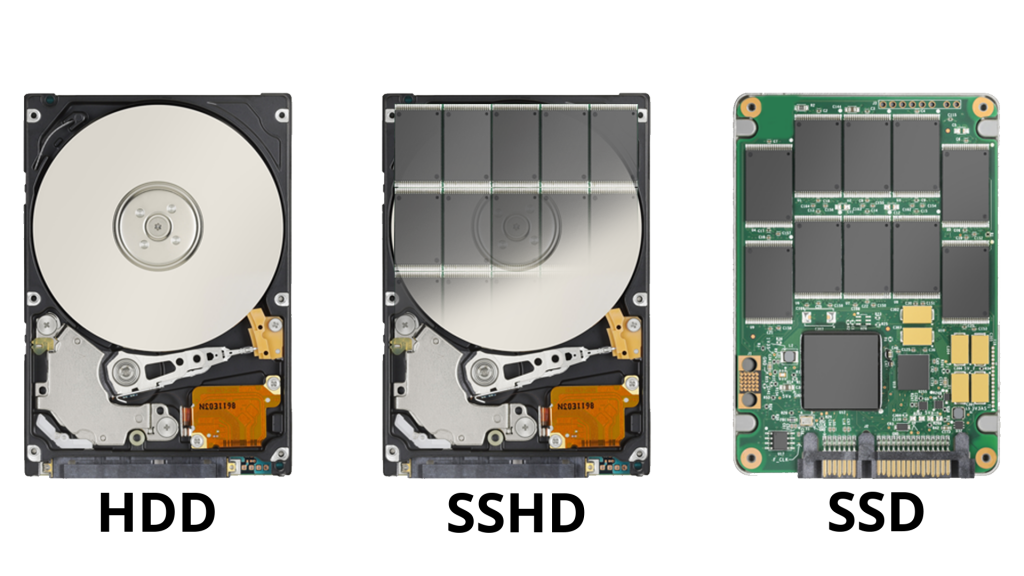Table of contents
You ought to choose wisely when it comes to storage, whether looking to buy a new laptop or desktop or simply upgrade your hard disks. To clear your confusion between HDD vs SSD vs SSHD, here we sort for you which one to choose when. So, let’s find out the difference between these storage devices so you can have a clear understanding of HDD, SSD, and SSHD.

HDD – Hard Disk Drive
Hard Disk Drives (HDD) are a vital component of the computer that stores data. It is the default data storage of most laptops and desktops that stores the operating system, all programs, data files, and installed apps. It uses magnetic storage, spinning disks, and a moving actuator arm to write, retain and fetch digital information whenever needed. HDD consists of a mechanical arm that moves to read and write the data. This means that HDD performs physical movement to retrieve any required data. HDD resides inside the computer and has spinning disks where data is stored magnetically. There’s a platter that is coated with a magnet on both sides. Due to this magnetizing mechanism, the data on HDD remains intact even power is switched off.
SSD – Solid State Drive
The Solid State Drive (SSD) stores data on non-volatile “flash” memory chips and has no moving parts. It stores all data in integrated circuits and follows the operating principle of a USB flash drive, but with a larger capacity and much faster processing. This is a relatively new storage technology mostly found in modern laptops. Unlike a traditional hard drive – an SSD has no moving parts and uses NAND flash memory. As compared to HDDs, this technology has reduced access time because users don’t need to wait for platter rotation to start up. This storage device comprises a grid of electrical cells that can quickly receive and send the data. The advanced SSDs have more NAND chips which make SSDs storage capacities close to HDDs. However, it comes with a price tag higher than consumer-grade HDDs.
SSHD – Solid State Hybrid Drive
Solid State Hybrid Drive (SSHD) is a combination of SSD & HDD. It is similar to the traditional hard disk with a very small quantity of solid-state storage built-in, approximately around 8 GB. Appearing as a single device to most operating systems, the drive has a controller chip that decides what data is to be stored on the SSD and which on the HDD. This means that SSHD has some features of the HDDs and some of the SSDs. It provides an ultimate solution for storage and performance within the budget. SSHD is a combination of fast NAND flash memory with a traditional hard drive. By combining the benefits of both technologies, SSHD provides you storage capacity like HDD and working performance like SSD.
What is better? HDD vs SSD vs SSHD
By now, you have a little idea about the SSDs, HDDs, and SSHD. Now, you may think about which storage device will best suit your needs. So, let’s compare HDD, SSD, and SSHD to help you choose the right one.
For Laptops
While the choice depends mostly on preferences, laptops have rooms only for a single drive thus making it a trickier decision. You can choose hard drives if you want to store more data inexpensively. HDDs are easily available and their storage capacity is exponentially larger than solid-state drives. But because of the moving parts, there is a risk of mechanical failure and data loss. Also, HDDs are slower than other variants. SSDs, on the other hand, will provide for the highest overall performance. However, if it is the largest amount of storage you are searching for, you may want to choose the SSHD. Contrarily, if you wish to spend the least amount of money, you might stick with the option of a traditional hard drive.
SSD does not only have limited storage capacity but is also expensive on your pocket when compared to traditional hard drives. A traditional 1TB hard drive would cost you one-sixth of what a 1TB SSD could weigh in your pocket. On the contrary, even an SSHD makes a smart choice as it would cost you a quarter of the 1TB SSD but will offer a balance between performance and space.
The SSHD learns which applications are most used and to accommodate faster loading times and better performance, those are stored in the Solid-state storage. An SSHD therefore may make your laptop boot faster but it still lags behind SSD in terms of performance speed.
Moreover, you must check for a drive that would fit within the storage slot on the laptop. Hence, when ordering the drive, you must check for the dimensions. For instance, a few ultra-portable laptops require a micro SATA drive smaller than 1.8 inches.
For Desktops
When it comes to HDD, this device uses more electricity to rotate the platters. This results in producing more heat and noise. But with no moving parts, SSDs are silent and more power-efficient. Since most PCs can accommodate multiple drives, the need for SSHD is bleak. A lot of newer PC’s come with both a traditional hard drive and an SSD with the operating system installed on the smaller capacity SSD along with a few essential functions and programs while the user data like music and pictures are mostly stored on the hard drive as they don’t require fast storage.
With the SSHD however, whether in a laptop or a pc, the advantage is that no special software or configuration is needed. It does not need you to decide where to store various programs or files.

